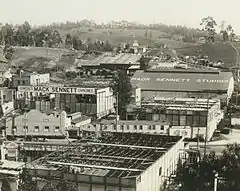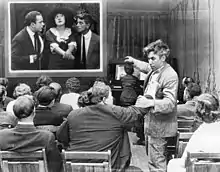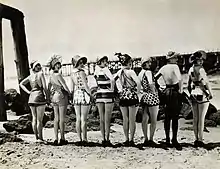 Mack Sennett Studios (ok. 1917) | |
| Państwo | |
|---|---|
| Siedziba |
Los Angeles |
| Data założenia |
4 lipca 1912 |
| Data likwidacji |
1935 |

Keystone Studios – wytwórnia filmowa z siedzibą w Edendale (dzielnica Los Angeles), w Stanach Zjednoczonych[1] działająca w latach 1912–1935.
Historia
Wytwórnia założona została 4 lipca 1912 roku jako Keystone Pictures Studio[2][3].
Twórcą przedsiębiorstwa był Mack Sennett, a pomagali mu: Adam Kessel (1866–1946) i Charles O. Baumann (1874–1931)[3], właściciele New York Motion Picture Company[4][5].
Przedsiębiorstwo przez kilka lat realizowało zdjęcia w okolicy Glendale Boulevard w Silver Lake[6]. W latach 1912–1915 filmy dystrybuowane były przez Mutual Film Corporation[7].
Główny budynek wytwórni był pierwszym w historii całkowicie zamkniętym studiem filmowym[3][8]; pozostał on na miejscu i zlokalizowany jest przy 1712 Glendale Blvd. (wcześniejsza nazwa tego odcinka drogi: Allesandro Ave.)[9][10].
Kiedy Sennett zaczął tworzć slapstickowe komedie z udziałem Keystone Cops (od 1912) i Bathing Beauties (od 1915) studio stało się popularne[11]. Charlie Chaplin został zatrudniony przez Sennetta przy filmach niemych w Keystone Studios, zaraz po jego przygodzie w wodewilu[12].
W 1915 roku przedsiębiorstwo Keystone Studios stało się niezależnym oddziałem produkcyjnym należącym do Triangle Film Corporation, studia założonego przez Sennetta, D.W. Griffitha i Thomasa Ince’a. W 1917 roku Sennett zrezygnował z Keystone i założył niezależne przedsiębiorstwo[3].
Wielu popularnych aktorów rozpoczynało swoje kariery w Keystone Studios, m.in. Marie Dressler[13], Harold Lloyd[14], Mabel Normand[15], Roscoe Arbuckle[16], Gloria Swanson[17], Louise Fazenda[18], Raymond Griffith[14], Ford Sterling[19], Harry Langdon[14], Al St. John[20] i Chester Conklin[21].
W 1917 roku Sennett, będąc już dobrze znanym w branży, opuścił studio by rozpocząć produkcję własnych filmów i nawiązał współpracę z wytwórnią Paramount[22]. Po odejściu Sennetta wytwórnia zaczęła podupadać, a w 1935 roku ogłoszono bankructwo Keystone Studios[23].
Przypisy
- ↑ Vincent Brook: Land of Smoke and Mirrors: A Cultural History of Los Angeles. Rutgers University Press, 2013, s. 217. ISBN 978-0-8135-5458-7.
- ↑ Motion Picture Studios of California - Page 2. movielocationsplus.com. [dostęp 2018-05-05]. [zarchiwizowane z tego adresu (2016-08-11)]. (ang.).
- 1 2 3 4 Keith M. Booker: Historical Dictionary of American Cinema. Scarecrow Press, 2011, s. 205. ISBN 978-0-8108-7459-6.
- ↑ Carl Bennett: Silent Era : Progressive Silent Film List. silentera.com. [dostęp 2018-05-05]. [zarchiwizowane z tego adresu (2018-05-05)]. (ang.).
- ↑ Anthony Slide: The New Historical Dictionary of the American Film Industry. Routledge, 2014, s. 145. ISBN 978-1-135-92554-3.
- ↑ James Stratton: A Star Is Born and Born Again: Variations on a Hollywood Archetype. BearManor Media, 2015, s. 15. ISBN 978-1-59393-819-2.
- ↑ Carl Bennett: Silent Era : Progressive Silent Film List. silentera.com. [dostęp 2018-05-05]. [zarchiwizowane z tego adresu (2012-05-27)]. (ang.).
- ↑ Erika Thomas: Max Factor and Hollywood: A Glamorous History. Arcadia Publishing, 2016, s. 20. ISBN 978-1-4671-3610-5.
- ↑ Stephen Michael Shearer: Gloria Swanson: The Ultimate Star. Macmillan, 2013, s. 26. ISBN 978-1-250-01366-8.
- ↑ Bryant Arnett: Chaplin Film Locations THEN & NOW - Keystone Studio. jerre.com, 1999. [dostęp 2018-05-05]. [zarchiwizowane z tego adresu (2016-04-30)]. (ang.).
- ↑ Catherine Cocks, Peter C. Holloran, Alan Lessoff: Historical Dictionary of the Progressive Era. Scarecrow Press, 2009, s. 390. ISBN 978-0-8108-6293-7.
- ↑ William Frank Smith, Robert Wicks: Communicating Through Word and Image. Winthrop Publishers, 1975, s. 168. ISBN 978-0-87626-139-2. Cytat: In 1913 Charlie Chaplin, who had had sporadic beginnings in English vaudeville, joined Keystone as one of Sennett’s players.
- ↑ Blair Miller: American silent film comedies: an illustrated encyclopedia of persons, studios, and terminology. McFarland & Co., 1995, s. 60. ISBN 978-0-89950-929-7. Cytat: (Marie Dressler, My Own Story, pp. 167–68.) Perhaps her most important silent film was Tillie’s Punctured Romance, made in 1914 and featuring Chaplin, Chester Conklin and Mabel Normand. It was made at Keystone studios.
- 1 2 3 Geoffrey Nowell-Smith: The Oxford History of World Cinema. Oxford University Press, 1997, s. 82. ISBN 978-0-19-874242-5.
- ↑ Karen Ward Mahar: Women Filmmakers in Early Hollywood. JHU Press, 2008, s. 122. ISBN 978-0-8018-9084-0.
- ↑ Bernard A. Drew: Motion Picture Series and Sequels: A Reference Guide. Routledge, 2013, s. 120. ISBN 978-1-317-92894-2.
- ↑ Charles Foster: Canadians in Golden Age Hollywood 2-Book Bundle: Once Upon a Time in Paradise / Stardust and Shadows. Dundurn, 2016, s. 641. ISBN 978-1-4597-3890-4.
- ↑ Blaise Cendrars: Hollywood: Mecca of the Movies. University of California Press, 1995, s. 7. ISBN 978-0-520-07807-9.
- ↑ Rob King: The Fun Factory: The Keystone Film Company and the Emergence of Mass Culture. University of California Press, 2008, s. 65. ISBN 978-0-520-94285-1.
- ↑ James L. Neibaur: Early Charlie Chaplin: The Artist as Apprentice at Keystone Studios. Scarecrow Press, 2012, s. 222. ISBN 978-0-8108-8242-3.
- ↑ Brent E. Walker: Mack Sennett's Fun Factory: A History and Filmography of His Studio and His Keystone and Mack Sennett Comedies, with Biographies of Players and Personnel. McFarland, 2013, s. 67. ISBN 978-0-7864-7711-1.
- ↑ Richard Lewis Ward: A History of the Hal Roach Studios. SIU Press, 2006, s. 17. ISBN 978-0-8093-8806-6.
- ↑ Mack Sennett Profile. tcm.com. [dostęp 2018-05-05]. [zarchiwizowane z tego adresu (2018-05-05)]. (ang.).
